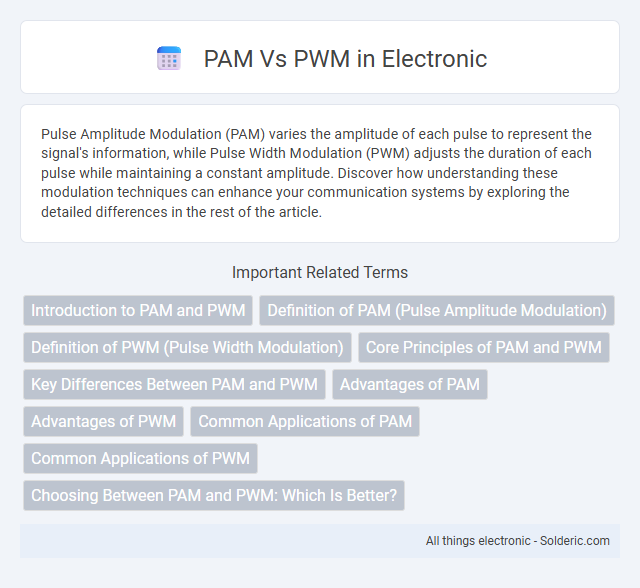Pulse Amplitude Modulation (PAM) varies the amplitude of each pulse to represent the signal's information, while Pulse Width Modulation (PWM) adjusts the duration of each pulse while maintaining a constant amplitude. Discover how understanding these modulation techniques can enhance your communication systems by exploring the detailed differences in the rest of the article.
Comparison Table
| Feature | PAM (Pulse Amplitude Modulation) | PWM (Pulse Width Modulation) |
|---|---|---|
| Modulation Parameter | Amplitude of pulses | Width (duration) of pulses |
| Signal Type | Analog or digital | Primarily digital |
| Application | Data transmission, telecom | Motor control, power delivery |
| Complexity | Moderate | Simple and efficient |
| Noise Susceptibility | Higher (amplitude sensitive) | Lower (timing sensitive) |
| Power Efficiency | Lower | Higher |
| Control Precision | Less precise | High precision control |
| Common Uses | Telecommunication, analog signal processing | LED dimming, motor speed control, power regulation |
Introduction to PAM and PWM
Pulse Amplitude Modulation (PAM) and Pulse Width Modulation (PWM) are essential techniques in signal processing and communication systems. PAM varies the amplitude of pulses in direct proportion to the analog signal's instantaneous amplitude, allowing efficient analog-to-digital conversion and data transmission. In contrast, PWM controls the width of each pulse based on the signal amplitude, providing precise control in power delivery and motor speed applications while maintaining a constant amplitude.
Definition of PAM (Pulse Amplitude Modulation)
Pulse Amplitude Modulation (PAM) is a modulation technique where the amplitude of each pulse in a signal is varied in proportion to the instantaneous value of the analog message signal. This method encodes information by changing the pulse heights while keeping pulse positions and widths constant. Understanding PAM is essential for comparing it to Pulse Width Modulation (PWM), which instead varies the pulse width to convey information.
Definition of PWM (Pulse Width Modulation)
Pulse Width Modulation (PWM) is a technique used to encode a message into a pulsing signal by varying the width of the pulses while keeping the frequency constant. This modulation method controls power delivery to electrical devices, optimizing energy efficiency and enabling precise control over motor speed, LED brightness, and other applications. The duty cycle, defined as the ratio of the pulse width to the total period, directly influences the average voltage and power transmitted to the load.
Core Principles of PAM and PWM
Pulse Amplitude Modulation (PAM) encodes information by varying the amplitude of each pulse in a signal, with each pulse representing an analog or digital value corresponding to the message. Pulse Width Modulation (PWM) conveys data through changes in the width or duration of each pulse while maintaining a constant amplitude, often used for controlling power delivery to devices. Both techniques rely on precise timing and amplitude control to accurately represent signals, but PAM focuses on amplitude variance, whereas PWM leverages time-based modulation.
Key Differences Between PAM and PWM
Pulse Amplitude Modulation (PAM) varies the amplitude of the pulses to represent the information signal, while Pulse Width Modulation (PWM) varies the duration or width of each pulse, keeping amplitude constant. PAM directly encodes the analog signal's amplitude, making it sensitive to noise and distortion, whereas PWM encodes information in pulse timing, offering better noise immunity and efficient power control. These fundamental differences impact their applications, with PAM commonly used in analog-to-digital conversion and PWM in motor speed control and power regulation systems.
Advantages of PAM
Pulse Amplitude Modulation (PAM) offers advantages such as simpler implementation and lower bandwidth requirements compared to Pulse Width Modulation (PWM). PAM signals allow more straightforward amplitude encoding, making it suitable for analog signal transmission and reducing complexity in modulation hardware. Your choice of PAM can enhance signal fidelity in applications where amplitude precision is critical.
Advantages of PWM
PWM offers precise control over motor speed by varying the duty cycle of the voltage signal, leading to higher efficiency and reduced heat generation compared to PAM. It maintains constant voltage amplitude while adjusting pulse width, minimizing power loss and improving energy conservation in electronic devices. Your systems benefit from enhanced reliability and smoother performance with PWM, especially in applications requiring fine-tuned power regulation.
Common Applications of PAM
Pulse Amplitude Modulation (PAM) is widely used in digital communication systems such as Ethernet and Optical Fiber Communication for transmitting data by varying signal amplitudes. PAM is essential in analog-to-digital conversion processes and in advanced multimedia signal transmission due to its efficient bandwidth utilization. Your choice of PAM can optimize data integrity and transmission speed in high-capacity networking environments.
Common Applications of PWM
Pulse Width Modulation (PWM) is commonly applied in motor speed control, where varying the duty cycle adjusts the power delivered to the motor. It is also extensively used in LED dimming, providing precise brightness control without color distortion. Furthermore, PWM plays a critical role in power supplies and inverters for efficient voltage regulation and signal modulation.
Choosing Between PAM and PWM: Which Is Better?
Choosing between PAM (Pulse Amplitude Modulation) and PWM (Pulse Width Modulation) depends on your specific application requirements such as noise immunity, power efficiency, and signal complexity. PAM offers simpler implementation and higher data rates but is more susceptible to noise, while PWM provides better noise resistance and power control, making it ideal for motor speeds and audio signals. Understanding the trade-offs between amplitude variation in PAM and pulse duration variation in PWM helps you determine the optimal modulation technique for your system's performance goals.
PAM vs PWM Infographic

 solderic.com
solderic.com